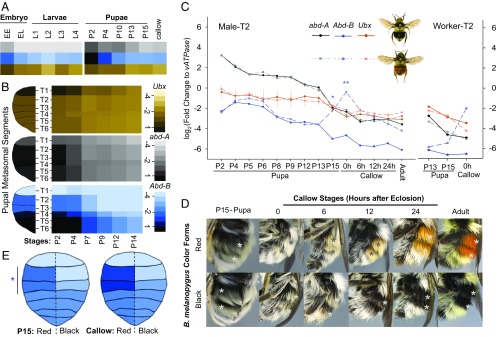Fig. 3.
Expression pattern of the bithorax complex (BX-C) homeotic genes during bumble bee development. (A) Relative expression of BX-C genes across B. impatiens developmental stages, including embryo, larvae (whole body), pupa, and early adult (metasomal tergites). (B) Spatial and temporal distribution of the BX-C genes in metasomal tergal segments of B. melanopygus pupae (worker, red form) from stage P2 to state P14. Shades for both (A and B) represent log2 relative fold change to vATPase. Right lane, scales for relative expression level. (C) Temporal expression pattern of the BX-C genes at the dimorphic metasomal tergal segment 2 (T2) of male B. melanopygus. Note that, in the callow adult stage, the relative abundance of Abd-B is higher than abdA and Ubx. *P < 0.01, **P < 0.001, Mann–Whitney U test. Abd-B expression was marginally significantly higher with <2× difference in the red form at P5E (P = 0.04) and P6 (P = 0.03); however, this difference is only seen in T2 but not T3 (SI Appendix, Fig. S2). A similar homeotic shift of Abd-B in the red form is also observed in polymorphic segments of workers (Right) (P = 0.057 at P15; no statistics applied at 0 h as only one sample is in black form). (D) Setal color development in late pupal and early adult stages of B. melanopygus. The stars indicate polymorphic segments. For P15 pupae, pupal cuticle was removed to reveal the developing adult setae underneath. The red and black setae are distinguishable in males starting from 0-h callow adult. Color continues to intensify in the first 24 h posteclosion. (E) Abd-B expression across abdominal tergites of B. melanopygus at stage P15 and in the newly eclosed callow adult showing up-regulation of Abd-B only in T2 and T3 for both of these stages, and only in the red form (segments on the Left side), not the other segments and the black form.

